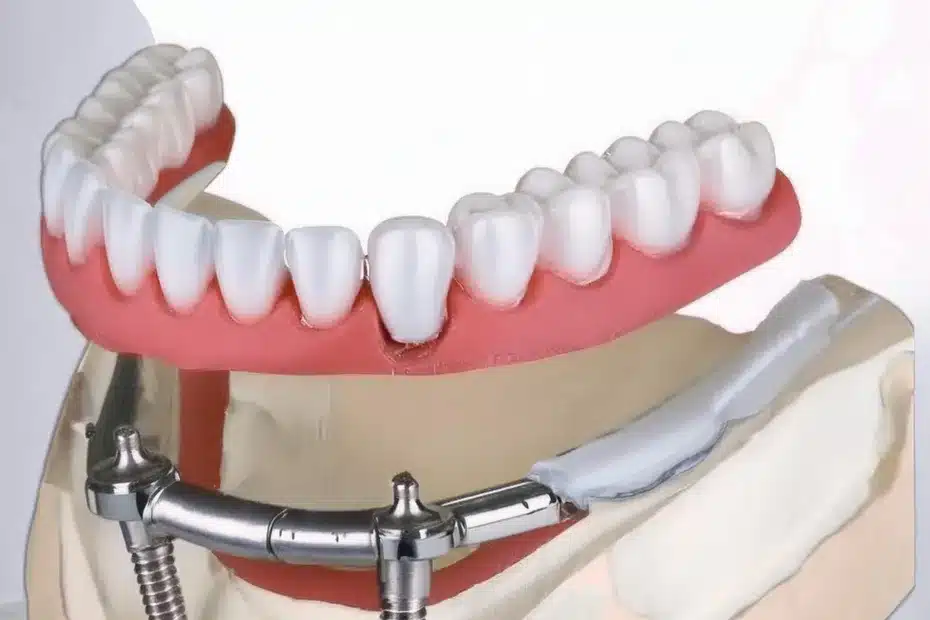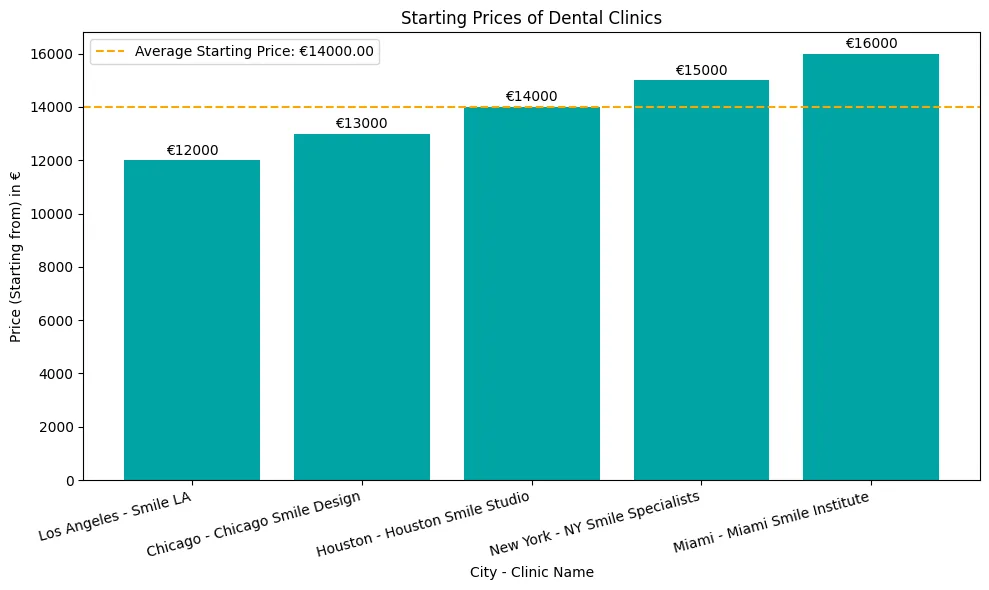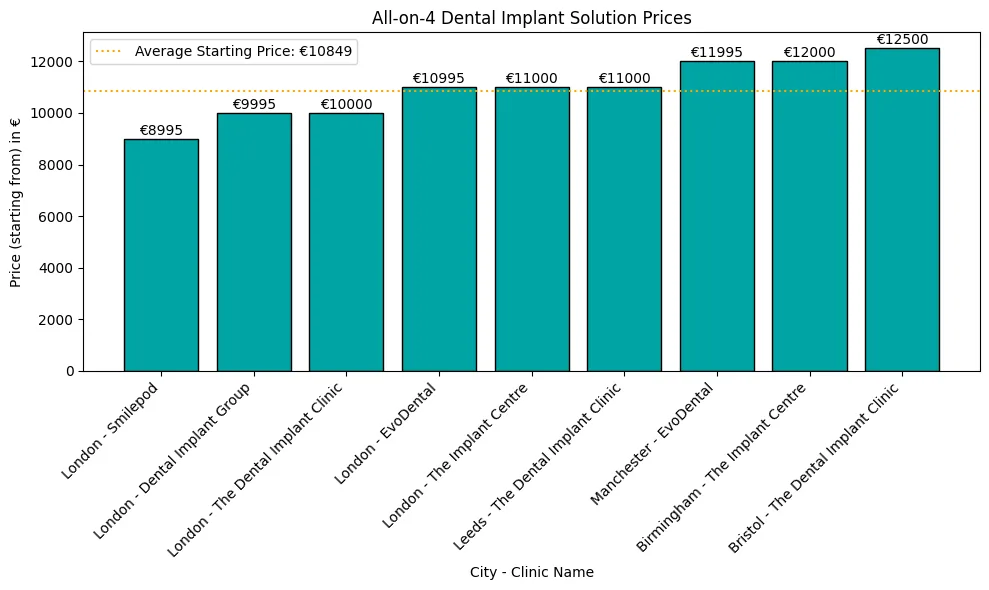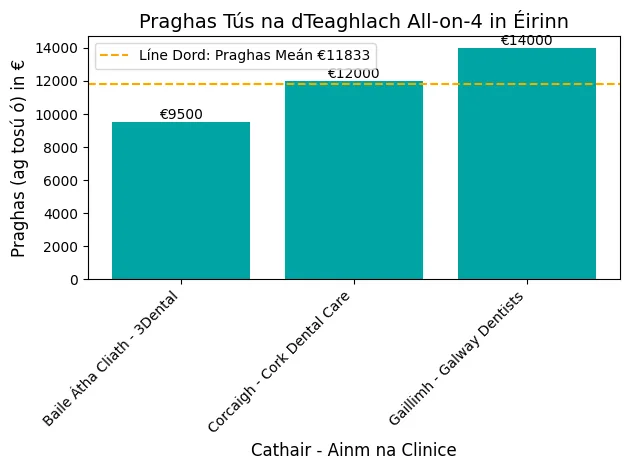Protezat me implant janë zgjidhja për ata me proteza të lirshme ose të papërshtatshme, duke trajtuar problemet e përtypjes së dobët dhe shqetësimit.
Zbuloni se si mbidenturat me implant mund të përmirësojnë shëndetin tuaj oral dhe cilësinë e jetës.
Çfarë janë mbidenturat e implantit?
Protezat me implant janë një lloj proteze që mbahet në vend nga implantet dentare, duke ofruar stabilitet, mbajtje dhe funksion më të mirë oral sesa protezat tradicionale.
Studimet tregojnë se pacientët me mbidentura të implanteve hanë më mirë dhe kanë shëndet më të mirë oral për shkak të përmirësimit të efikasitetit dhe rehatisë së përtypjes.
Llojet e implant dentar protezat janë të lëvizshme, të fiksuara, të mbajtura me shufra dhe me top, secila e përshtatur për nevojat tuaja individuale për rezultatet më të mira estetike dhe funksionale.
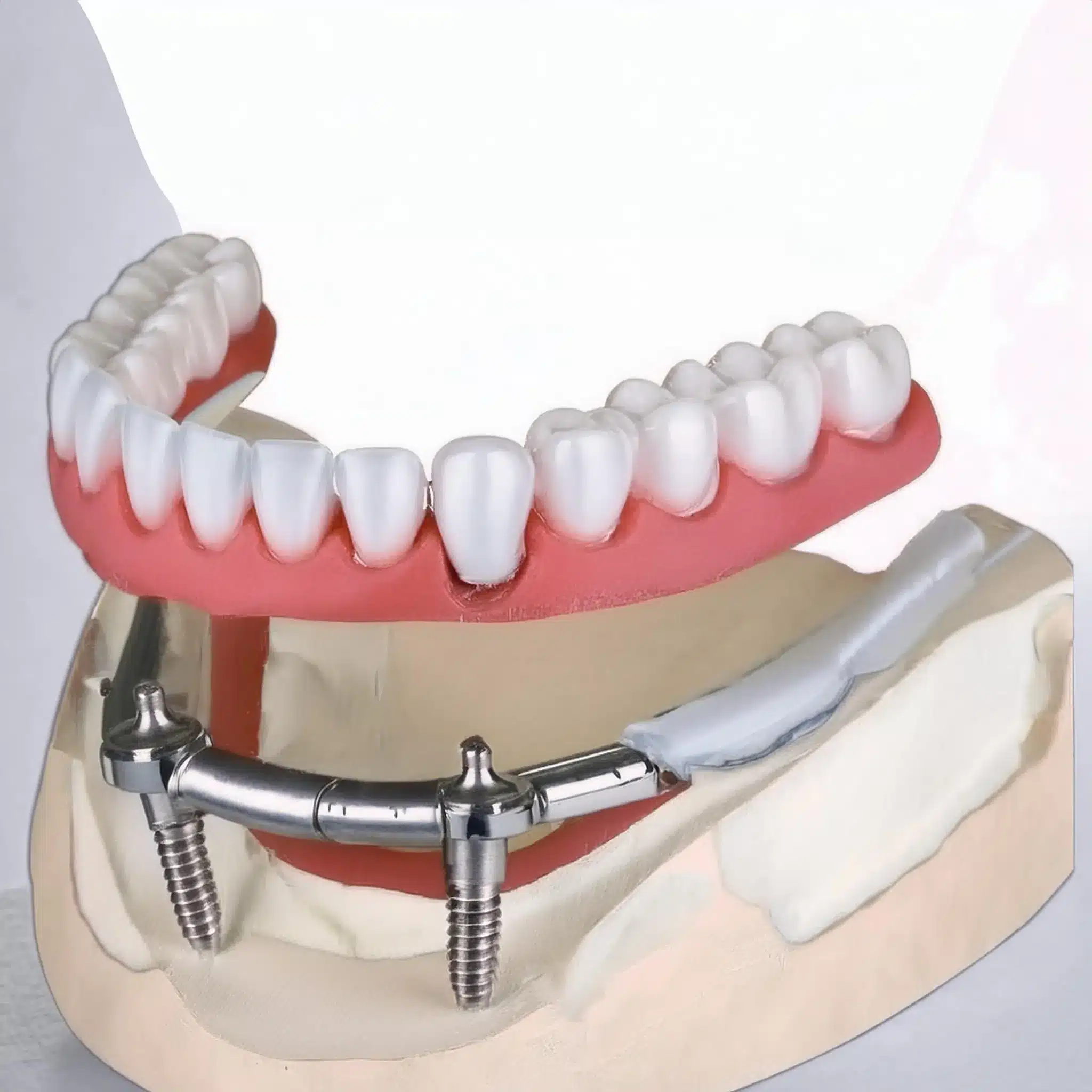
Llojet e mbidenturave të implanteve
Protezat e implantit vijnë në disa forma, secila për nevoja të ndryshme. Njohja e opsioneve do t'ju ndihmojë të zgjidhni më të mirën për çdo pacient.
Proteza të lëvizshme të mbështetura nga implantet
Protezat e lëvizshme mund të hiqen nga pacienti për t'u pastruar dhe mbahen në vend me anë të implanteve me bashkëngjitje si lokatorë ose kapëse.
80% e pacientëve i shohin protezat e lëvizshme të mbështetura nga implantet të përshtatshme dhe të lehta për t'u mirëmbajtur (4).
Kjo është për ata që duan fleksibilitet me stabilitetin e implanteve.
Proteza fikse të mbështetura nga implantet
Të njohura edhe si proteza hibride, këto janë të lidhura përgjithmonë me implantet dhe mund të hiqen vetëm nga një dentist.
Ato ofrojnë një ndjesi të sigurt, natyrale dhe 40% më shumë efikasitet përtypjeje sesa opsionet e lëvizshme (5).
Protezat fikse janë për ata që duan një zgjidhje të përhershme.
Mbështetje të mbidenturave të mbështetura nga implantet e mbajtura me shufër
Këto përdorin një shufër metalike të ngjitur me implantet, e cila siguron një bazë të qëndrueshme për protezën.
Hulumtimet tregojnë se mbidenturat e mbajtura me shirit reduktojnë tendosjen e implantit me 30% dhe ulin rrezikun e dështimit të implantit (6).
E mirë për pacientët që kanë nevojë për mbështetje shtesë për shkak të densitetit të kufizuar të kockave.
Mbështetja e dhëmbëve me implant të mbajtur me top
Shtojcat në formë topi i mbajnë këto proteza te implantet dhe lejojnë lëvizje të lehta për të shpërndarë në mënyrë të barabartë forcat e përtypjes.
Hulumtimet tregojnë se mbidenturat e mbajtura me top rrisin kënaqësinë e pacientit me 25% për shkak të stabilitetit dhe komoditetit të tyre (5).
E mirë për ata që duan siguri dhe fleksibilitet.
| Lloji i mbidenturës | Metoda e bashkëngjitjes | Përfitimet kryesore | Kandidatët idealë |
|---|---|---|---|
| Proteza të lëvizshme të mbështetura nga implantet | Lokatori ose bashkëngjitjet e klipit | Komoditet, lehtësi në pastrim | Pacientët që kërkojnë fleksibilitet |
| Proteza fikse të mbështetura nga implantet | Ngjitja e përhershme me implantet | Rritja e efikasitetit të përtypjes, stabiliteti | Pacientët që preferojnë zgjidhje të përhershme |
| Mbështetja e dhëmbëve me implant të mbajtur me bar | Shirit metalik me protezë me kapëse | Stabilitet i zgjeruar, tendosje e reduktuar e implantit | Pacientët që kanë nevojë për mbështetje shtesë |
| Mbështetja e dhëmbëve me implant të mbajtur me top | Shtojcat e topit | Shpërndarja e balancuar e forcës, rehati | Pacientët që kërkojnë rehati dhe stabilitet |
Përfitimet e mbidenturave të implanteve
Protezat e mbivendosura me implant kanë shumë përparësi ndaj protezave tradicionale; ja disa prej tyre:
Stabilitet dhe mbajtje më e mirë
Një nga përfitimet më të mëdha të mbidenturave të implanteve është qëndrueshmëria dhe mbajtja më e mirë e tyre.
Ndryshe nga protezat tradicionale që mund të rrëshqasin ose lëvizin, mbidenturat e implanteve janë të ankoruara në implantet dentare.
Kjo do të thotë që protezat qëndrojnë të fiksuara në vend, një përshtatje më e sigurt dhe më e rehatshme.
Një studim tregoi se 96% e pacientëve me mbiproteza të mbështetura nga implanti raportuan mbajtje dhe stabilitet më të mirë se ata me proteza tradicionale (1).
Ky stabilitet i rritur i jep pacientit më shumë besim dhe rehati, veçanërisht kur flet ose ha.
Estetika dhe funksionaliteti
Protezat implantuese ndihen më të sigurta dhe duken më natyrale. Për shkak se ato janë ngjitur me implantet, ka më pak nevojë për baza të mëdha protezash që mund të ndryshojnë pamjen e fytyrës.
Kjo do të thotë një buzëqeshje dhe strukturë e fytyrës me pamje më natyrale.
Sipas hulumtimeve klinike, pacientët me proteza të mbështetura nga implantet kishin 35% kënaqësi më të lartë me pamjen e tyre sesa ata me proteza tradicionale (2).
Plus, funksioni i përmirësuar i mbidenturave të implanteve lejon përtypje dhe të folur më natyral, në përgjithësi cilësi më të mirë të jetës.
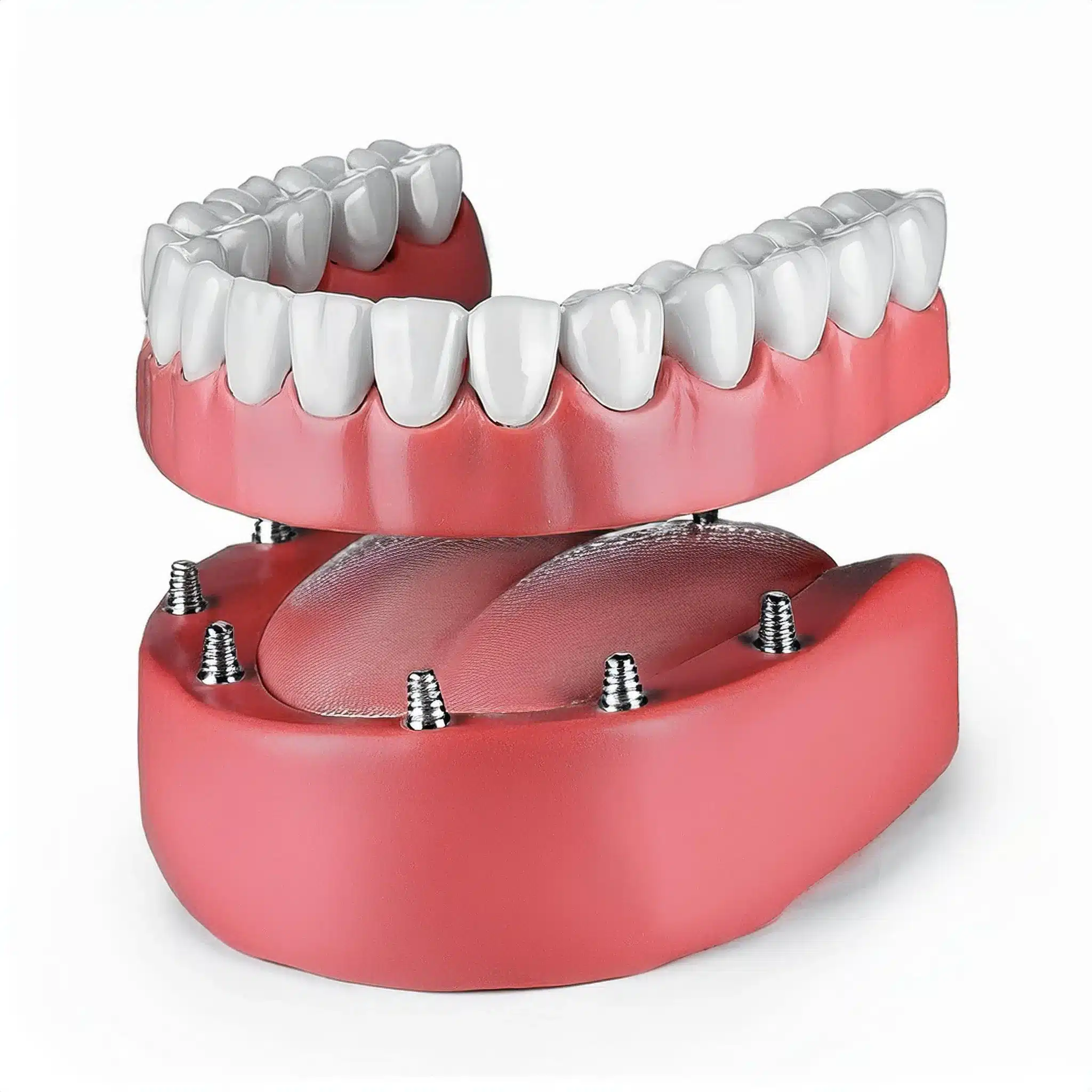
Të ushqyerit më të mirë dhe shëndet oral
Një tjetër avantazh i mbidenturave të implanteve është efekti i tyre pozitiv në të ushqyerit dhe shëndetin oral.
Protezat tradicionale mund ta bëjnë të vështirë përtypjen e disa ushqimeve, gjë që mund të çojë në një dietë të kufizuar dhe mangësi ushqyese.
Protezat implantuese ofrojnë një forcë më të qëndrueshme kafshimi, duke i lejuar pacientët të përtypin një shumëllojshmëri më të gjerë ushqimesh.
Studimet tregojnë se pacientët me mbiproteza të mbështetura nga implanti mund të përtypin 85% të të gjitha llojeve të ushqimit në krahasim me 60% me protezat tradicionale (3).
Plus, mbidenturat e implanteve ndihmojnë në ruajtjen e kockës së nofullës dhe parandalojnë humbjen e kockave që shpesh ndodh me protezat tradicionale për shëndetin afatgjatë oral.
Opsionet e procedurës së implantimit për mbidenturat
Procesi i marrjes së mbidenturave të implanteve përfshin disa hapa, secili prej të cilëve është vendimtar për arritjen e një rezultati të suksesshëm.
Ja çfarë të presësh:
Vendosja e implantit
Hapi i parë në terapinë e implanteve është vendosja e implanteve dentare në kockën e nofullës.
Kjo bëhet nën anestezi lokale për rehati të pacientit.
Gjatë procedurës, implantet e titanit futen në mënyrë kirurgjikale në kockën e nofullës.
Hulumtimet tregojnë se shkalla e suksesit të vendosjes së implantit dentar është 95% për një periudhë 10-vjeçare (6).
Kjo shkallë e lartë suksesi i bën implantet një bazë solide për mbidenturat për stabilitet dhe funksion afatgjatë.
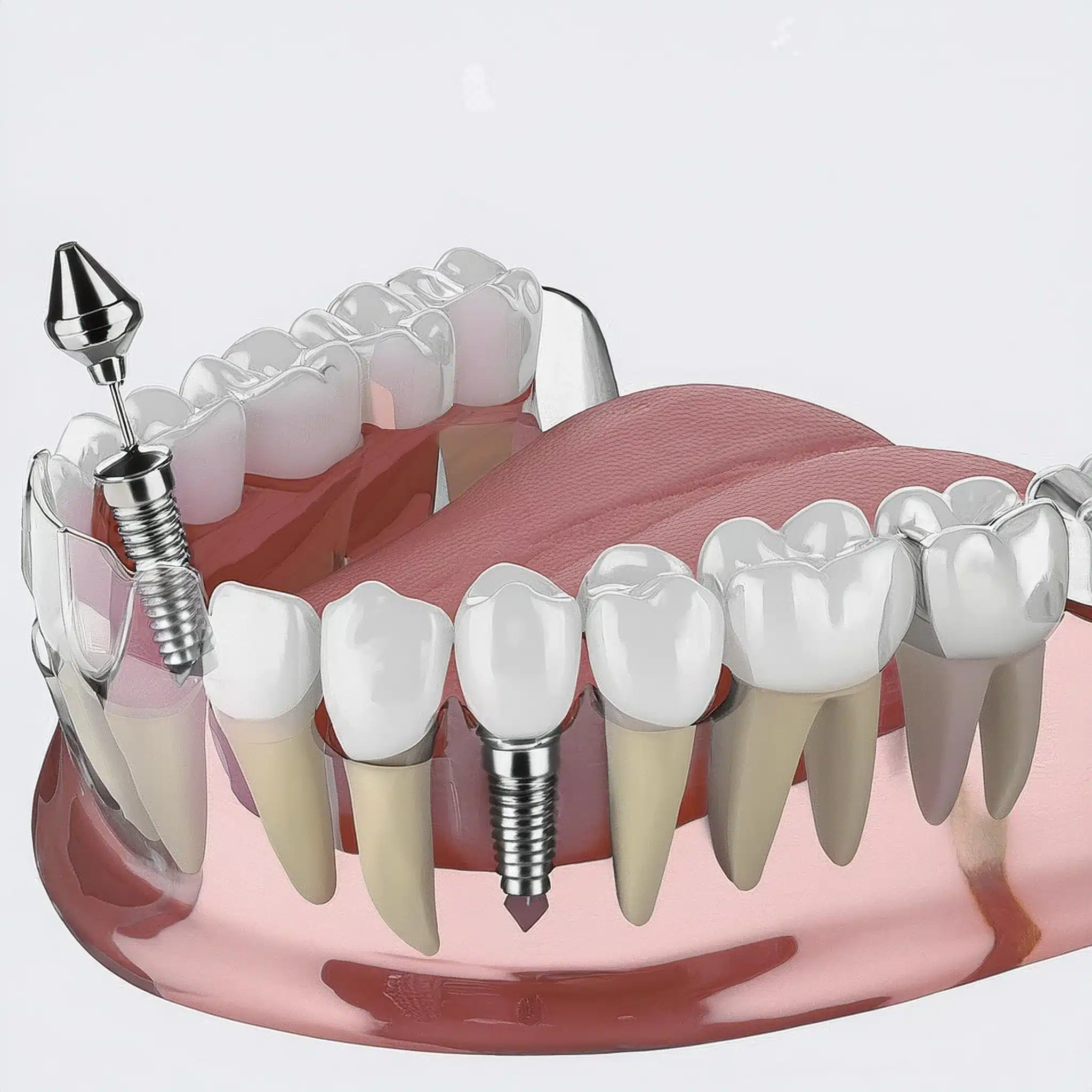
Vendosja e abutmentit
Pasi implantet të jenë integruar me kockën e nofullës - një proces i quajtur osseointegrim që mund të zgjasë disa muaj - hapi tjetër është vendosja e abutmenteve tek implantet.
Këto abutmente veprojnë si lidhës midis implanteve dhe mbidenturave.
Hulumtimet tregojnë se 90% e mbidenturave të mbështetura me implant me abutment mbeten të qëndrueshme dhe funksionale pas 5 vjetësh (5).
Ky hap është vendimtar për një përshtatje të sigurt të mbidenturave, për rehati dhe përdorshmëri.
Përshtypjet dhe përshtatja
Hapi i fundit është marrja e përshtypjeve nga goja e pacientit për të krijuar një mbidenturë të përshtatur me porosi.
Kjo siguron që protezat të përshtaten mirë mbi implantet dhe abutmentet për rehati dhe estetikë optimale.
Një mbidenturë e përshtatshme shpërndan forcat e kafshimit në mënyrë të barabartë nëpër implante, duke reduktuar rrezikun e shqetësimit dhe dështimit të implantit.
Të dhënat klinike tregojnë se pacientët me mbidentura të montuara mirë raportojnë 30% më shumë kënaqësi të përgjithshme sesa ata me ato të montuara keq (4).
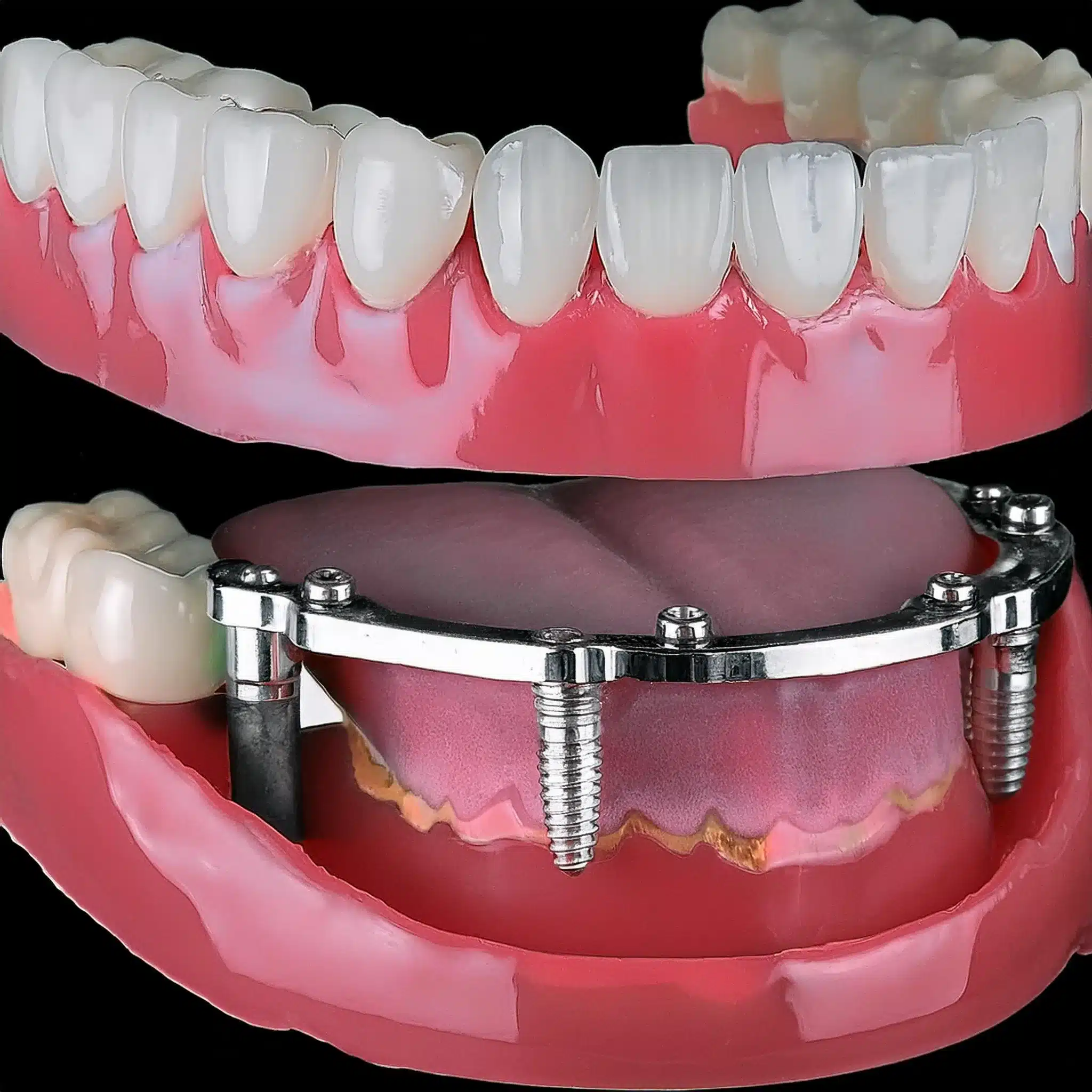
Kush mund të mbajë mbidenturat e implantit?
Protezat me implant mund të jenë një opsion për shumë pacientë, por disa faktorë përcaktojnë përshtatshmërinë e saj.
Njohja se kush është një kandidat ideal mund të ndihmojë në marrjen e vendimeve të informuara.
Kandidatët idealë
Kandidatët idealë për mbidenturat e implanteve janë ata që kanë densitet të mjaftueshëm të kockave të nofullës për të mbështetur implantet.
Ata që u mungojnë shumica ose të gjithë dhëmbët dhe kanë proteza tradicionale të lirshme ose të pakëndshme mund të përfitojnë gjithashtu nga një mbidenturë e mbështetur nga implanti.
Hulumtimet tregojnë se mbi 70% pacientësh me vëllim të mjaftueshëm të kockave dhe shëndet të mirë oral janë kandidatë për mbidentura të mbështetura me implant (1).
Pacientët gjithashtu duhet të jenë në gjendje të mirë të përgjithshme shëndetësore dhe pa kushte që mund të pengojnë shërimin, si diabeti i pakontrolluar ose çrregullime të caktuara autoimune.
Humbja e kockave dhe shartimi
Pacientët me humbje të konsiderueshme të kockave në nofullën e sipërme mund të jenë ende kandidatë për mbidentura të implanteve, por ata mund të kenë nevojë për procedura shtesë si shartimi i kockave për të ndërtuar kockën e nofullës përpara se të vendosen implantet.
Shartimi i kockave ka një shkallë suksesi prej 85% për sigurimin e një themeli të qëndrueshëm për implantet (2).
Kjo përfshin përdorimin e kockave nga një pjesë tjetër e trupit ose një zëvendësues sintetik për të rritur vëllimin e kockave.
Të dhënat klinike tregojnë se pacientët që patën transplantim të suksesshëm të kockave përpara vendosjes së implantit kanë të njëjtin shkallë suksesi si ata me kockë natyrale (6).
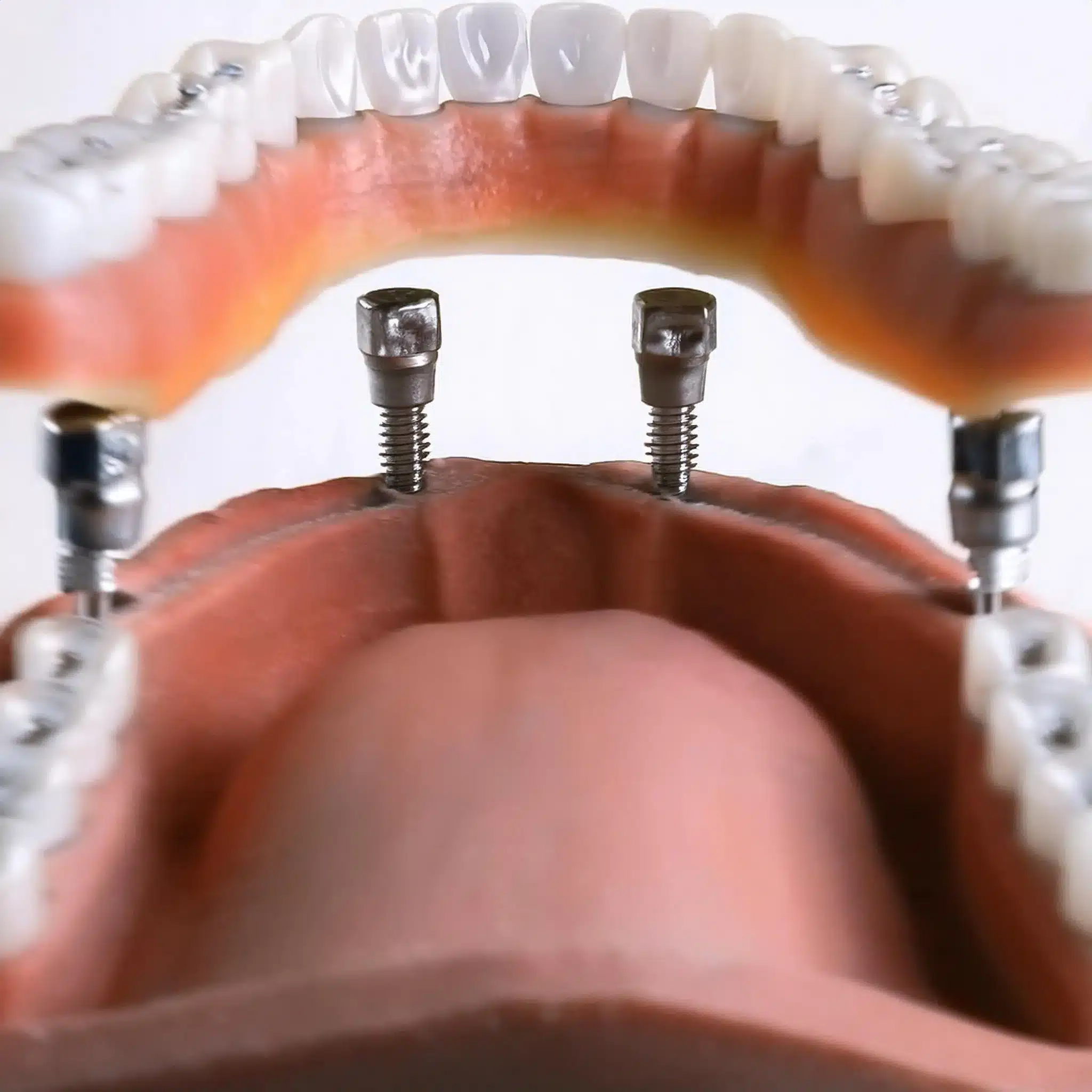
Përfundim & Çështje kryesore
Merr kryesore:
Protezat me implant janë një alternativë e qëndrueshme dhe komode tek protezat tradicionale për estetikë dhe funksion.
I përshtatshëm për pacientët me densitet të mjaftueshëm kockor dhe shëndet të mirë në përgjithësi, ata me humbje të konsiderueshme të kockave mund të kenë nevojë për procedura shtesë si shartimi i kockave.
Ka lloje të ndryshme të mbidenturave implantare- i lëvizshëm, i fiksuar, i mbajtur me shufra dhe i mbajtur me top - për t'iu përgjigjur nevojave të ndryshme për komoditet, stabilitet dhe preferenca estetike.
Procedura e implantit dentar përfshin disa faza: vendosja e implantit, ngjitja e abutmentit dhe montimi me porosi; secila është thelbësore për një rezultat të suksesshëm.
Të dhënat klinike mbështesin shkalla e lartë e suksesit dhe kënaqësia e pacientit nga mbidenturat e implanteve; është një opsion praktik dhe i preferuar për shumë pacientë pa dhëmbë.
konkluzioni:
Protezat me implant janë një zgjidhje për ata që duan të përmirësojnë stabilitetin e tyre dentar, funksionalitetin dhe shëndetin e përgjithshëm oral.
Me një shkallë të lartë suksesi dhe lloje të ndryshme të disponueshme, është një opsion i gjithanshëm për nevojat individuale të pacientit për të përmirësuar cilësinë e jetës dhe mirëqenien orale.
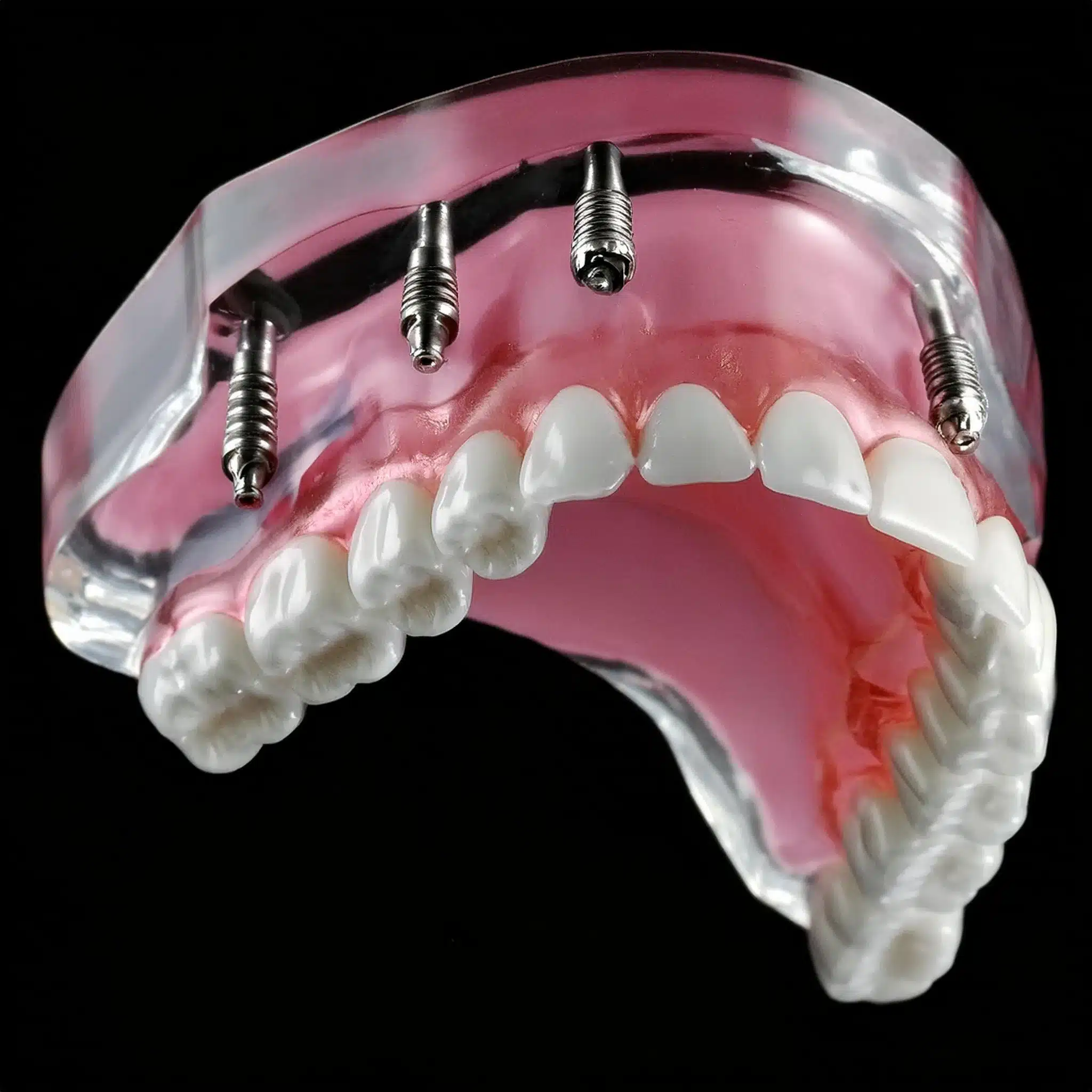
FAQ
Referencat
Feine JS, et al. Deklarata e konsensusit të McGill mbi protezat. Protezat me dy implante mandibulare si standardi i parë i kujdesit për pacientët pa dhëmbë. Implantet Maxillofac Oral Int J. 2002; 17 (4): 601-602.
Adell R, et al. Një studim afatgjatë i implanteve osseointegruese në trajtimin e nofullave totalisht pa dhëmbë. Implantet Maxillofac Oral Int J. 1981; 10 (1): 11-25.
Artikulli: Një studim afatgjatë i implanteve osseointegruese në trajtimin e nofullave tërësisht pa dhëmbë
Naert I, etj. Rezultatet afatgjata prej 10 vitesh me implantet ITI. Clin Oral Implants Res. 1991; 2 (1): 30-34.
Artikulli: Rezultatet afatgjata prej 10 vitesh me implantet ITI.
Thomason JM, etj. Deklarata e konsensusit në York. Br Dent J. 2009; 207 (4): 185-186.
Artikulli: Mbështetje me dy implante mandibulare si standardi i parë i kujdesit për pacientët pa dhëmbë – Deklarata e Konsensusit të York-ut
Sadowsky SJ. Proteza e mbështetur me implant për harkun pa dhëmbë: konsiderata të projektimit. J Protetë Dent. 1997; 78 (1): 28-33.
Artikull: Proteza e mbështetur me implant për harkun pa dhëmbë: konsiderata të projektimit
Carlsson GE, et al. Protezat e mbivendosura me implant dhe rrënjë: një rishikim i literaturës dhe disa të dhëna mbi preferencat e pacientit. Int J Prosthodont. 1996; 9 (1): 34-40.
Artikulli: Mbështetja e dhëmbëve me implant dhe rrënjë: një rishikim i literaturës dhe disa të dhëna mbi preferencat e pacientit

